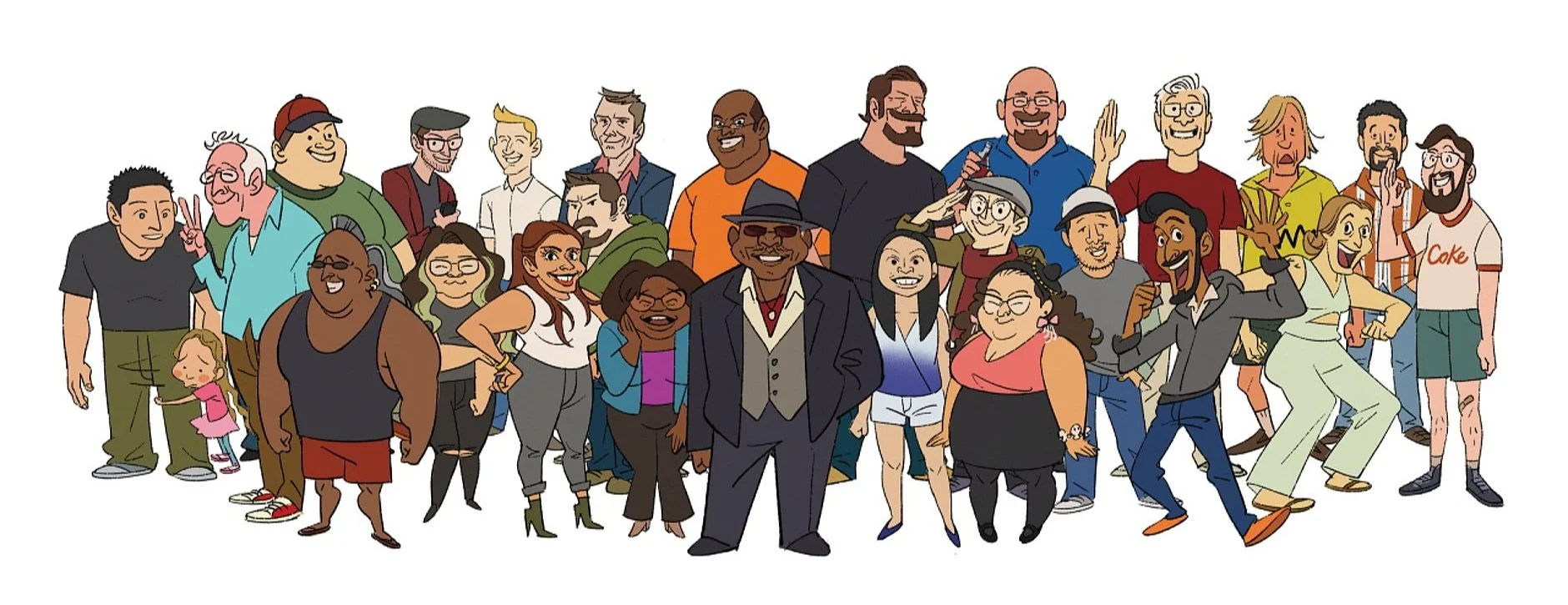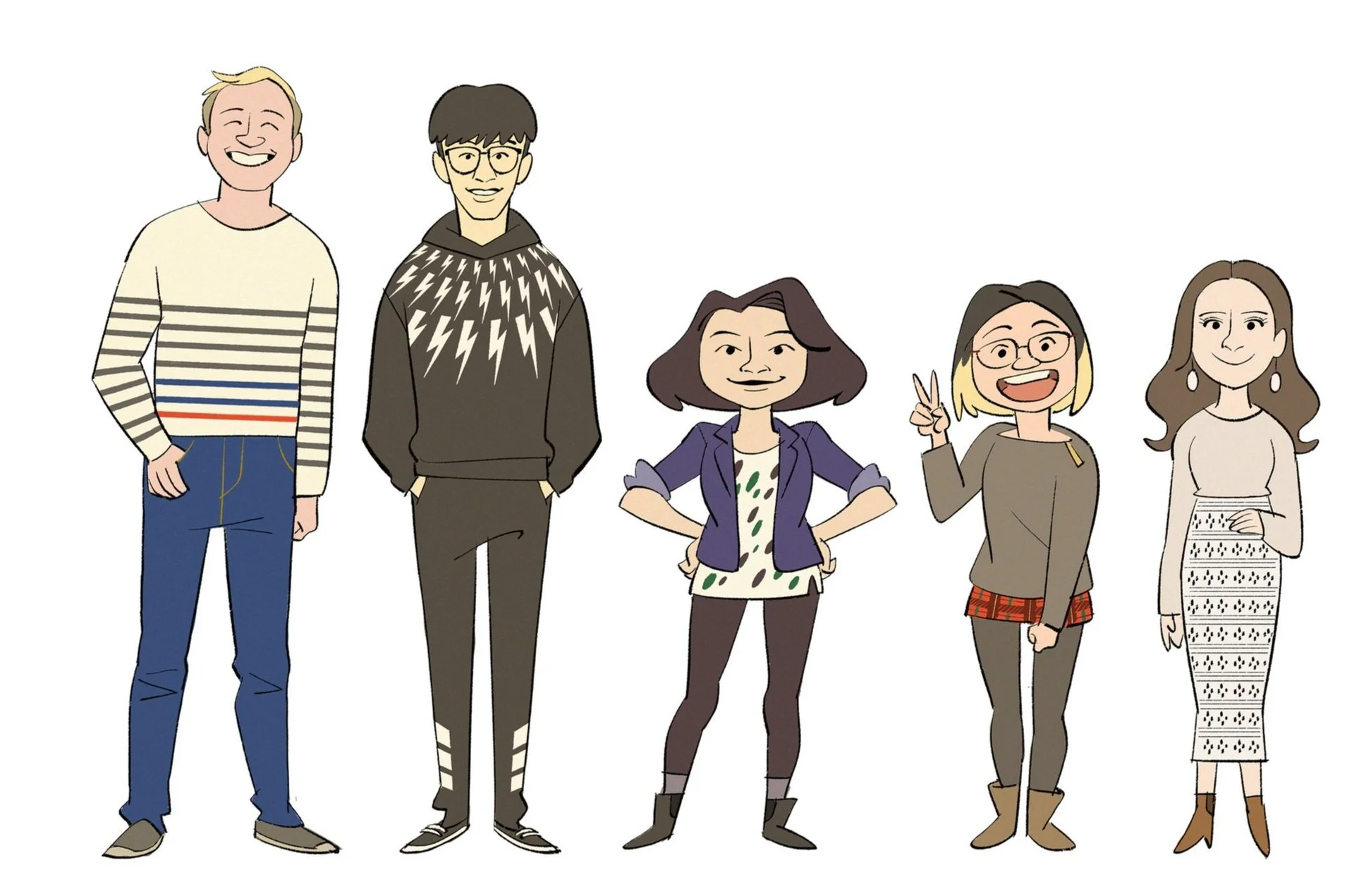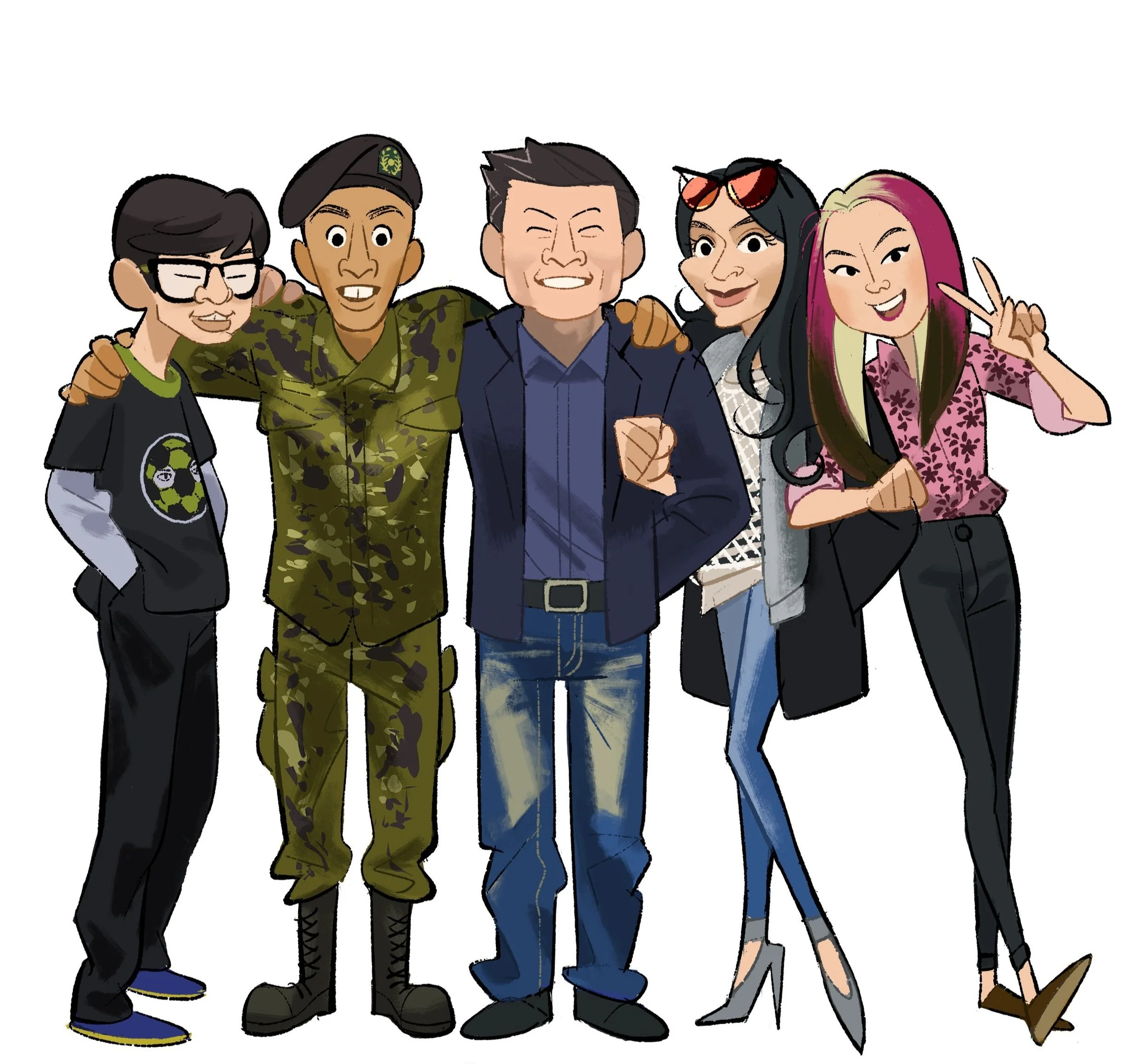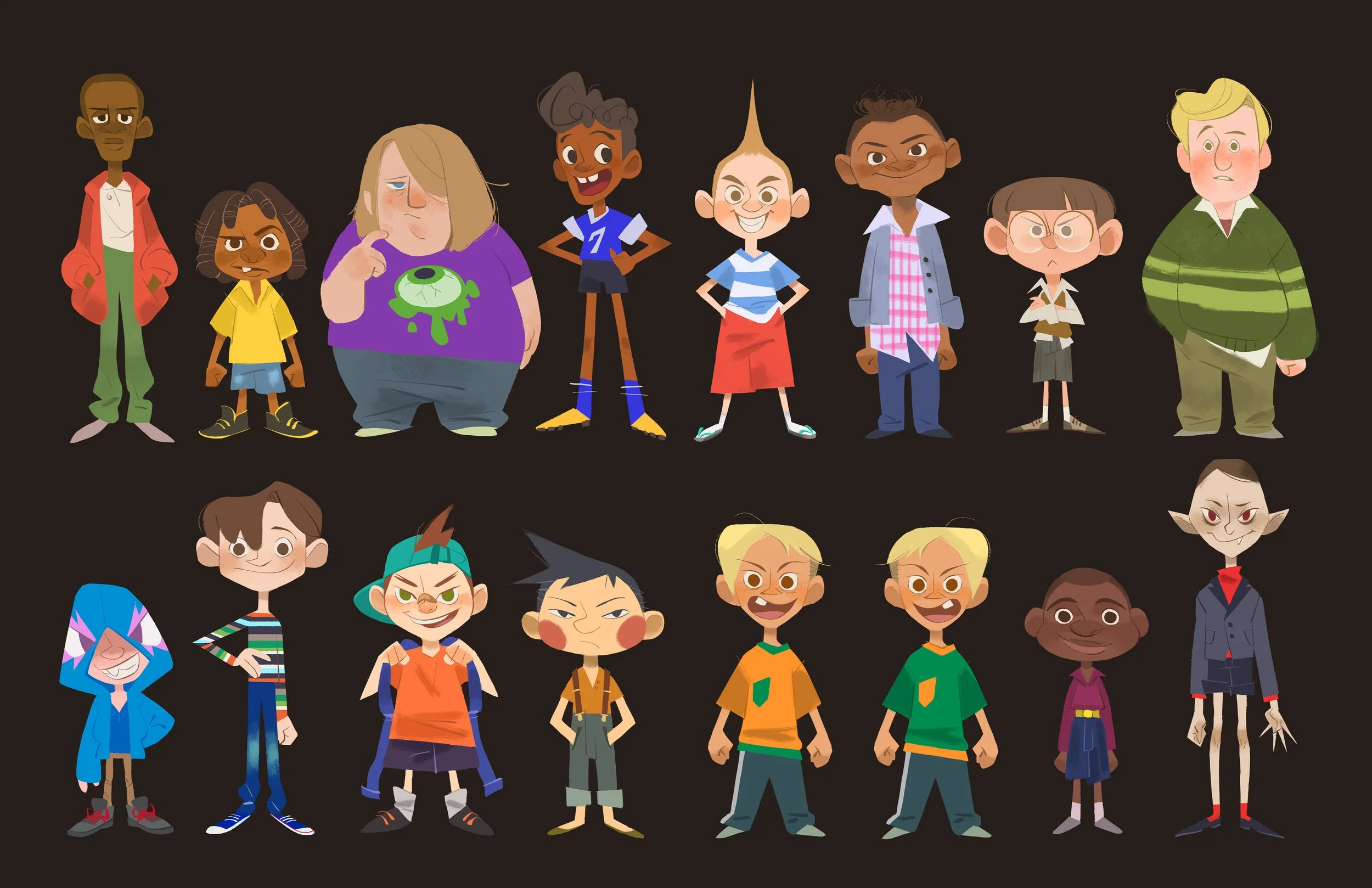Soyeon Yoo
/Where did you grow up? At what age did you start thinking about pursuing an artistic career?
I grew up in Seongnam, Gyeonggi-do, South Korea and I moved to the US to go to college back in 2011. I’ve been always drawing, watching cartoons, and anime and I started pursuing my dream as an artist since I was a kid. I was a very introverted child and I remember the only time I felt confident was when I was doing arts and crafts, or drawing. As I grew up, I discovered that working in the animation industry as an artist was a possibility, and I have wanted to be an artist in animation ever since then. When I was in high school, Pixar held an exhibit of its artwork in Korea which blew my mind and I wanted to be an artist who contributes to those amazing animated films that inspire people. I decided to pursue my dream in the United States.
Did you go to an art school or are you self-taught? How did you develop your skills?
Ever since I wanted to pursue my career as an artist, I started going to an art academy to try to build up my skills. When I was in middle school, I went to an art academy to prepare for the nationwide entrance exam into an animation high school located in Hanam, South Korea. There were about 40 other kids in my class alone who also wanted to get accepted into that school and it was in an extremely competitive environment. I did not pass, and it was then that I fully understood just how many other amazing and talented artists there were in the world. I ultimately went to a different school to prepare for the entrance exams into an art university, hoping to be accepted into one of their visual design or animation programs. Preparation for the test was especially grueling. The entrance exam is a 4-hour test in which students are given a random prop that they must draw realistically using graphites. They must then use poster paints to do a creative piece based on that prop. An example would be that the prop is a pair of scissors and the creative prompt would be to design a futuristic city based on scissors. Since the test is only 4 hours long, the drawing technique was key to success, so I was trained to memorize all sorts of compositions and lighting methods.
In South Korea, however, academic scores are still a top priority no matter what career path you wish to pursue and to even be eligible for the artist entrance exam, a student had to have high enough academic grades. Mine weren’t so high at the time and my teacher told me I was ineligible to test for the school that I wanted to attend. I didn’t want to attend any other program, so I decided to study abroad in the states majoring in animation. Luckily I got accepted at the California Institute of the Arts and I studied character animation there. Not only am I studying at an art academy, but I could say I am also self-taught in a way as I draw in my sketchbook every day growing up. Creating random characters I have in mind, lots of fanart, copying photos from a movie to study tone and value, sometimes studying anatomy with an artbook from my dad, and copying a favorite page from a manga. Sometimes playing with different materials markers, printer inks, pens..etc. I just had fun drawing in my own spare time.
Have you always been supported in your artistic path or has it been challenging to let your family and friends understand your choice?
I am very grateful that my parents and friends have always been supportive. I did not have any conflict with my parents. I have gone to art academies growing up since I was in 3rd grade, and they have always supported me. I remember when I did not get accepted to an animation high school, it was one of the biggest disappointments of my young life. It even made me insecure about my own abilities, and I was doubting if animation was the right career path for me to pursue.
My parents were cheering me up and my dad was showing me a video explanation about a motivational book called 'The Secret'. He wanted to encourage me to really visualize my goals and he wanted to point out that it's not always a straight line between where I am and where I want to go, and I can't always detect when things will turn around, but perseverance and a belief in oneself are key. My parents never doubted my career path and my choice. They always believed in me. I would not be able to be where I am without their support.
What was the strongest influence you had when you were growing up ( artists, movies, cartoons, comics, etc.. )?
I think the strongest influence I had was Naruto. I was just fascinated by the drawings and stories. Each character has their own personal story and distinctive design. I like how the main character develops throughout the series. I remember drawing fanart of Naruto a lot. I admire the manga artists Masashi Kishimoto (Naruto), Takeshi Obata (Death Note and Hikaru no Go), and Yusuke Murata (Eyeshield 21), who have been my inspiration for a long time. They all have amazing draftsmanship and design sense. I actually never knew about American football until I read Eyeshield 21. Yusuke Murata's drawing is so marvelous that I could feel the movement from panel to panel. There are so many influences and they are the reasons why I wanted to pursue my dream as an artist.
Some other influences are all the Disney movies such as Snow White, Mulan, Little Mermaid, and Aladdin. Other animes that I love are Dragonball, Slam Dunk, One Piece, Hunter X Hunter, D-Gray Man, Bleach, Gurren Lagann, Naruto. And some American cartoons that I grew up with are Spongebob SquarePants, AHHH! Real Monsters, The Wild Thornberrys, and CatDog.
What is your process in creating your art and what are your favorite tools?
First, I brainstormed and gathered all the photo references I needed. I go through handouts-all the information and references-the client sent out to me. I highlight the descriptions that apply to the design, like personalities or particular features. Then I rough out the basic shape and silhouette for the character and go into details. If I draw more graphic styles, I skip the tie-down stage and go straight to do color-blocking using the shape tool. After that, I provide several different passes on the same characters and tweak their body shapes and proportion. Furthermore, I try different styles of the characters if clients haven’t decided which styles they want to go for. I usually work in Photoshop since it’s easy to quickly edit and color.
What part of the creation process is the most fun and easy and what part is the hardest?
Coming up with a new idea from scratch and roughing out the idea-exploration stage is always the hardest, but also the most fun and creative part. Cleaning and polishing the artwork takes the longest but easiest part because at that stage I clearly know what is the direction I am going for.
What is a typical day for you, and who are the people you work, collaborate, or share your creative time with?
For my current gig, I usually participate in handout meetings with the design team, directors, and writers. I work closely with the lead character designer and art director. I do rough passes first and check with the lead character designer and once it gets approved, I do a clean pass. When an assignment gets approved by the lead designer, it goes to the art director for final approval. I create a look of individual characters from scratch, I usually work based on characters' descriptions and the script from the show. And also, I provide additional information and references such as turnaround, expression, and mouth charts for characters for animators.
What are some of the things you have learned from other artists with whom you have worked or whose work you have seen?
I've learned a lot by working with colleagues and friends I’ve met during my career. Because I have been hopping on to lots of different projects, I get inspired by the shows that I’ve been on. I learned a lot from Chris Mitchell, art director for Rocky and Bullwinkle, while I was working as a prop designer at Dreamworks Television Animation. It was my first time working as a prop designer at that time and also I wasn’t too familiar with the graphic and illustrated style that the show was going for. This show has a totally different language, so getting used to working on this specific style made me get out of my comfort zone. Even though I wasn’t working as a character designer at that moment, I think I learned a lot from looking at all the amazing character designs from that show. I was able to develop different art styles inspired by the style of that show.
Is there something that you have designed that you are most proud of?
The most recently released show I've worked on is Tig Notaro’s fully animated stand-up comedy special, Tig Notaro: Drawn. I am particularly proud of my work here because I designed 'stage Tig', the main character who's on stage throughout the special telling jokes. I also did turnaround and expression sheets, and special poses for 'stage Tig' as well. I had a great opportunity to take a pass on 'stage Tig' and the final design got the most of my input, and I think I captured her personality well and made a great cartoon version of her.
Also, I worked as a visual development artist for different segments by providing original background designs and prop designs for various scenes. My supervising director, Greg Franklin, liked the aesthetic of one of my personal art pieces, so he let me do the final character passes and additional incidental characters. He also assigned me to do design (and painting some backgrounds as well). It was challenging to create backgrounds from scratch since I never worked as a background designer and painter professionally, but luckily I was familiar with the style that they were going for that segment, so I got it pretty fast. I was also in charge of doing character development for 'kid Tig' from another different segment as well. It was cool to see all the characters and backgrounds I created on the screen.
What projects have you worked on in the past and what are you working on at the moment (if you can tell us)?
The first project I worked on as a character designer after I graduated college was Valt the Wonder deer at DreamEast Pictures. After I wrapped up season one of Valt the Wonder deer, I worked as a storybook artist for Miles from Tomorrowland at Wild Canary Animation studio. I briefly worked as a storyboard revisionist for LEGO Elves at Studio Mir.
After that, I got an opportunity to work as a prop designer for Adventures of Rocky and Bullwinkle at Dreamworks TV. Also, I got to work as a prop designer/model designer for High Guardian Spice and Onyx Equinox at Crunchyroll Studio. I worked as a character designer for various projects such as Tig Notaro: Drawn, Cave Club, and the music video 'Vote' for ABC'S Black-ish and helped out development projects at Six Point Harness. Currently, I am working as a Character Designer at Disney Television Animation on an upcoming animated series, Hailey's On it!.
Do you have a long-term career goal? What would your dream project be?
I want to be “a strong” Character Designer, having in-depth knowledge of character design techniques. I want to improve my overall skill set while continuing to work in the animation industry in roles like character, background, and color design so that I may work as an Art Director someday. Also, I would like to work in feature films as a Production Designer. Furthermore, I would love to create a Korean culture show that has a very original and personal story that audiences can connect with.
Working in-house for a company or freelancing: what suits you best? And why?
Freelancing is nice timewise since I don’t have to commute to the office and I like the flexibility. I don’t mind working at home for short projects but I like working in-house for a company. Since Covid hit, I've been working at home full-time. I miss connecting and getting to know my coworkers who're working on the same project. I remember when I got a 2-month-long freelance project, I still worked at the office and it was nice getting to know people at the company. I have been very lucky to have met so many amazing people during my career working in-house who have not only taken me under their wing but also created safe, fun, and rewarding experiences.
What advice would you give to an artist who is dealing with an artist's block? How do you boost your imagination and keep yourself creative?
Going back and rewatching all the inspirational films and tv shows helps to remind me why I wanted to draw and helps get back that enthusiasm. I look at the artists’ works I admire as well to boost up my passion, thinking ‘I want to be a great artist like them’. Also, It is important to not feel too pressured to make a ‘good’ artwork to showcase in public. I still have this anxiety of wondering If my artwork is presentable enough for public viewing. This struggle and pressure distract me from being creative sometimes. I’m trying to focus on enjoying making artwork to make myself less pressured, and remind myself (but also want to say to other people) not to lose the mindset of making art because this is what you love to do the most.
Concept art, animation, illustration, comics, you name it. There are so many careers and when you are very young, sometimes you know only one thing: you simply love to draw. In your opinion, what should a young person take into consideration to make the right decision when choosing an artistic path?
Try lots of things you are interested in first. Nowadays many artists experiment a lot, some do concept art and storyboarding, or do storyboarding and comics at the same time. I think It doesn't have to be one or the other. It would be helpful to look over your personal work and ask specific questions about what you are enjoying the most. Do you enjoy telling the story through what media? Films, comics, or illustration? Perhaps you enjoy designing instead? Something like this.
Fortunately, I was able to try lots of things by taking classes such as storyboard, layout, 2D& 3D animation, and character design. It helped me to decide what I wanted to do the most during college. The reason I choose to pursue character designs specifically is that drawing characters was the most fun out of all the options for me.
In your own experience, what would you suggest to someone who is inspired by your work and wants to follow in your footsteps: should they work in one consistent style, or work on many different ones?
It is cool to see artists have their own distinct styles that no one can mimic. Personally, I like to work on many different ones, but It can be challenging getting used to a totally different style than the one I used to at first. On the other hand, trying out different styles also helped me to get out of my comfort zone and boundaries to improve as an artist. Not that I’m saying do not work in one consistent style, at least in the TV animation industry, I found out it is beneficial to be a versatile artist so that I get more opportunities to get to work on different projects.
What’s your point of view about the industry today: what are the expectations for someone who wants to make a living with an artistic career?
If you expect to work as an artist in the TV Animation industry, it’s mostly full-time contractor work so you might be hopping onto lots of projects in a short amount of time depending on how long the production for the project would be. The animation community is large but the industry is small so I end up bumping into my previous coworkers and colleagues a lot. Always be polite, responsible, and professional to your colleagues. Also, it’s important to be on social media nowadays to put your work out there as well as to promote yourself.
Who are the artists who inspire you the most today and what are some of your favorite designs out there?
I look up to so many artists around the world: Jamie Hewlett, Cory Loftis, Fabien Mense, Chase Conley, and Sylvain Marc, just to name a few. The art of ‘Zootopia’ is one of my biggest inspirations. All the character designs and environmental designs are amazing. There are many personalities in the design aspects, but also very solid structures inside of the design. I love the animated short pilot called ‘Verne on Vacation’ by Sylvain Marc. This short is one of my all-time favorites, the character designs are so fun! Also, I love the art of ‘Spiderman: Into the Spiderverse’. It has such a cool style. It was really refreshing (and mind-blowing) that they went for a style never seen on the big screen before.
Social networks, crowdfunding websites, print-on-demand online services, and so on. New media on the Internet are connecting the artists directly with their fans like never before. In your opinion, how is this affecting the industry and what are the pros and cons?
I think social media it's great for artists as it gives more exposure to their work and makes them find an audience. On top of that, new media platforms made it also possible for artists to make income as independent creators (through lots of online services such as Instagram, YouTube, and Patreon). Employers can find many talented artists and reach out to them easier. There are so many amazing artists out there with big followers, but when it comes to hiring, sometimes there’s a misjudgment that artists who have lots of followers always are better than others who don't. I think people shouldn’t judge the potential and skills of an artist by how many followers they have, but instead, should look at their portfolios.
When clients contact you for a commission, what essential info should they include in their very first email in order to communicate with you efficiently and effectively?
Written descriptions of what clients want and reference images of how this wants to be turned in are the key. This way it’s easier for me to picture what clients want before I start working.
Finally, where can we see your art online and get in touch with you? How can we buy your creations and support your work?
You can check out my artwork on my website ( soyeon-yoo.com ) and feel free to follow me on my Instagram page ( instagram.com/yoosy1012 ) for updates about my work.
Thank you, Soyeon :)























































































